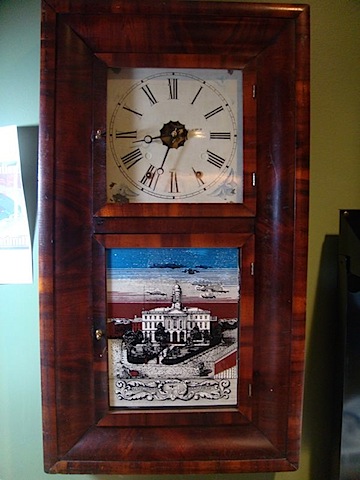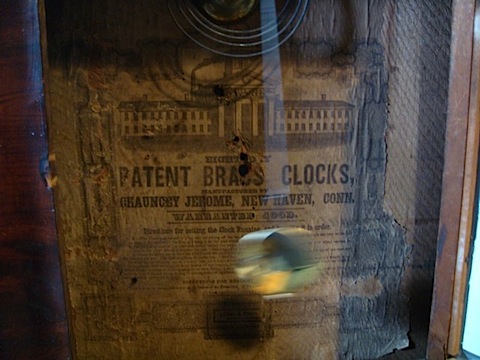My most recent clock family member arrived on Thursday. It is one that I plan on keeping: a mid-19th century (sometime before 1853) “ogee” style clock made by the Chauncey Jerome factory in New Haven, Connecticut:
An “ogee” clock doesn’t describe a brand or mechanism: instead, ogee describes the shape of the curves in the moulding. Because the name has been attached to a general style and vintage of clock, sometimes you’ll see an “ogee” without the correct type of case design. Mine is finished with “American rosewood” veneer which is almost perfectly intact.
My clock was made sometime before the reforming of the Chauncey Jerome business into the New Haven clock company in 1853. That makes the clock itself older than Canada and the American Civil War, which is a bit sobering. The case and mechanism are original: the tablet (the back painted glass at the bottom of the clock) is possibly original, but could be a contemporary (circa 1850) replacement. The face is a replacement from a different clock (a 30 hour mechanism) of about the same age. The weights for the 8 day weight driven mechanism are quite massive- on the order of ten pounds each.
These were “common” clocks at the time, although the eight day mechanisms like mine were more expensive and are accordingly quite a bit rarer. Clocks of this kind were the ones that the American settlers moving west would put in the back of their wagons. Most of them are in rather rough shape today as they weren’t considered art or fancy furniture- they were practical necessities which, although often made to look fairly attractive, were not babied.
It is pretty astounding to me to have something of this age in such workable condition in my house. It is fully functional: this isn’t a “fixer” clock for me, but a “collectable”, and will be staying with me. It cost less than a Playstation 3: not cheap, but not exorbitant for something with this much history.



interesting. Just probing the web. Went to a garage sale today and picked up an Ogee Jerome that looks exactly like yours but with a single door. Does however have the two glass panes, the bottom has flowers painted on. Seems to work fine. Does not chime – it is broken – but seems to keep perfect time so far. Do not know if it is 8-day or 30-hr.
Hi, Brad! Welcome to my blog. The 8 day vs 30 hour question can be figured out pretty quickly by winding it up and seeing how long it runs before needing to be re-wound. There are other things that, to a real expert, would give a hint. One little thing I “learned” is that the position of the winding arbours seems to be specific to the mechanism duration, for example. If the arbours are near the center of the clock face above the “4” and “8” mark, it is likely a 30 hour mechanism; if they are closer to the edge in the midst of the “5” and “7” marks, it is likely an 8 day mechanism.
If you want more information on clocks, you might want to check out the National Association of Watch and Clock Collectors (NAWCC) forums. What little I know has mostly come from asking questions of the experts there. Regardless, you have a real piece of history there!
Hello: We own/inherited a Jerome clock like this with a sailboat painted on the glass door. I want to sell it. It needs repair, however. The face needs touching up and the works are loose but otherwise it is a pretty old clock belonging to my great grandfather. Do you have some idea of what I might sell it for? Thank you, Linda
Greetings, Linda. First, to be clear: I’m definitely *not* the person to go to for accurate or professional clock appraisals. Small things can have a huge impact on the value of a clock or watch, and I’m basically an interested but inexperienced amateur.
That said: If the clock is a Chauncy Jerome in working order and “complete”, comparable to mine, it is probably worth between $300 and $400. If it is non functional or incomplete, it is probably still worth something: perhaps half as much. Reconditioning an old clock like this can easily cost more than the value of the clock.
I own a chauncy jerome wall clock similar to the one pictured.
I need some parts for it,any body know a good supplier of parts and possibly photos of the works. This particular clock is cable and weight driven.
We have a Chauncey Jerome clock. It is most probably made before the company became the New Haven clock company as it simply says ‘ Made by Chauncey Jerome’. It is in poor condition. It is a single door with two panes, the bottom one is missing. The face looks original and its’ arbours are by the 4 and 8. We have the weights and the bottom piece of wood which has broken off. Any comments?
Hi, Mary! From the arbour position, I believe you probably have a 30 hour clock. I’m pretty much a novice, however, in terms of putting a date or value to a clock, so I’d suggest you might want to post your question (along with some pictures) on one of the dedicated clock/horology forums. The one I rely on is the National Association of Watch and Clock Collectors message board (http://mb.nawcc.org/index.php).
Restoring one of these old clocks is truly a labour of love. Don’t expect to make any money in the process 🙂
Hi there,,
I see amessage from Brad in reply to yours about you chauncey jerome clock is there any website that you know of that deals entirely with clocks by this maker. i also have a clock similar to what Brad describes and would like to see whether or not the clock face has been changed in any way. The clock used to belong to my father whom if still alive would be in his ninties and he says it belonged to his parents. Its an eight day clock with a rather dull thud chime in working order the case looks ebony but has single door with flowers painted on second half in an ovalish shape.
Regards
Simon Richardson
Hello, Simon. I don’t know of any website dedicated to Chauncey Jerome clocks. Generally, if I have any questions I use the National Association of Watch and Clock Collector forums as a starting place for answers. I have a link to those forums in my reply above to Brad. Good luck tracing the details of your clock!
Hi Kelly. Just to let you know I’m in England and have a eight day clock on my dining room wall. Single door,painted flower galss panel which has now completly faded and dull thud as an hour chime, which is why I googled your web site looking for answers to correct the chime.Otherwise has worked fine for years, acquired from my wife’s late grandfather estate but we’ve no idea of its history which is a shame. Find it very easy to repair and maintain and is original apart from the pendulum which I made from a brass brazing rod and an old english penny with the face polished off.Thanks for the information. Peter
Hello, Peter, and Welcome! The “dull thud” could be a matter of the striker/hammer resting on the gong between strikes, effectively muffling its vibration. I haven’t had to adjust mine, but I believe it is fairly simple, something on the order of lightly bending either the gong spring or the hammer arm. However, I’d probably suggest registering and asking your question on the NAWCC forums (http://mb.nawcc.org/index.php) to get more expert advice.
Thanks Kelly but afraid its not that simple. I don’t know how authentic the strick mechanism is.The backplate is covered with a thin brass cover shaped to the backplate.Should this be touching the plate? This is held on by a thick brass washer with a hole drilled through. The end of the spring goes through this hole with the centre of the spring bent to one side to accomodate the screw.This is all very flimsy and I’ve had to stabilise with a spot of solder.There’s also washers either side of the brass cover to stop its movement when its all screwed up, as its a sloppy fit.Thanks for your comments and I’ll try the NAWCC forum. Peter
I have a clock exactly like this with a little different picture of what I am assuming the capital bldg. in Wash. Can you give me any idea as to the worth of this clock? It came from my great-grandmother who passed away around the late 30’s, early 40’s at the age of 96